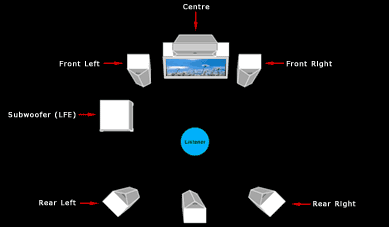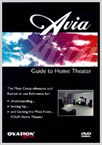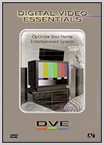|
A home theatre system uses two
main speakers, just like an ordinary stereo system, but adds
three extra speakers: two behind the listener, and one above
or below the TV (which should be placed between the front
speakers). The front left and right speakers handle most of
the film's music, and directional audio effects.
The centre channel's primary
duty is the reproduction of dialogue and general background
audio ('foley') effects, while the two surround speakers
manage the film's ambient (background or 'atmosphere')
effects, such as wind, raindrops or echoes, and are
responsible for literally 'surrounding' the viewer with
sound. When combined, these five speakers totally immerse
the viewer in sound; no longer will you merely observe films
from a distance, you will feel as though you are actually
in the film, participating in the action.

The heart of any home
theatre is the AV (audio/video) amplifier or receiver.
Although similar to a conventional amplifier, an AV
amplifier includes five or more channels of amplification;
that's at least three more than a conventional stereo
amplifier. These miltiple channels of amplification are
needed to power a home theatre's five or more audio
channels. The processing system that allows an AV amplifier
to reproduce the sound heard in theatres is called 'Dolby
Pro Logic'.
Dolby Pro Logic 'unfolds'
four separate audio channels from conventional stereo
recordings. Any stereo recording is capable of including
surround-sound information, and nearly all of the videos at
your local video store include surround-encoded stereo
soundtracks. All you need to hear this extra information is
an amplifier or receiver with Pro Logic processing and a
hi-fi video. Many TV programmes are also recorded in
surround-sound and with the same amplifier and video you can
listen to your favourite shows in full surround-sound.


In addition to Dolby Pro
Logic, two audio systems that have become increasingly
common on AV amplifiers are 'Dolby Digital' and 'DTS Digital
Surround'; both generically known as '5.1' systems (as both
commonly have five independent full-range audio channels and
one limited-frequency bass channel). Both Dolby Digital and
DTS offer significant improvements over Dolby Pro Logic,
including increased channel-separation and considerably
greater dynamic range (the difference between the loudest
and quietest sounds that can be reproduced).
Unlike Dolby Pro Logic, both
Dolby Digital and DTS Digital Surround include completely
discrete full-range surround channels, allowing
'split-surround' audio effects (that is, stereo surround
audio effects). Split-surrounds allow much more precise
sound localisation, placing sounds precisely behind the
listener, not just vaguely "behind… somewhere". Both systems
also include an optional dedicated 'LFE' or bass channel,
which significantly enhances bass reproduction. Dolby
Digital and DTS Digital Surround are currently restricted to
the newer DVD videodisc and D-VHS formats and the latest DSS,
DTV and HDTV digital television systems.


Even though a home theatre
uses three more speakers than a conventional stereo system,
these speakers needn't be large and can be discreetly
placed, allowing them to seamlessly integrate with a home's
decor. For those who wish to avoid the hassle of choosing an
AV amplifier and extra speakers, complete home theatre
packages are readily available. Although much more
convenient than individually selected 'separates' based
systems, you should bear in mind that these systems will not
offer the performance levels component-based systems are
capable of.
Many reputable
manufacturers, such as Sony, Pioneer and Denon, offer
all-in-one home theatre packages that include five speakers,
Pro Logic and Dolby Digital/DTS processing, and five or more
channels of amplification in a single convenient package.
These systems are usually small enough to be tucked away out
of sight, and are controlled by a single remote control. As
an added bonus, these systems cost considerably less than
systems that use separate components.
Whether you want an
entry-level or a top-of-the-line system, your first port of
call for advice and information should be your local
specialist audio dealer (ie. not your local Big Al's 'Lectronic
Superstore). Your local home theatre dealer can advise you
which systems best suit your needs, and answer any questions
you might have about home theatre technology and features.


To get the most from your
new purchase, I suggest calibrating your new surround-sound
system with a specialised calibration disc (DVD) such as
'Digital Video Essentials' or the 'Avia Guide to Home
Theater'. These discs can also be used to calibrate your
television, allowing the films you watch on TV to look as
good as their makers intended. Good luck and happy hunting!
|